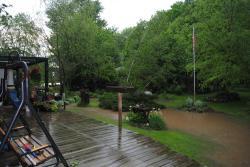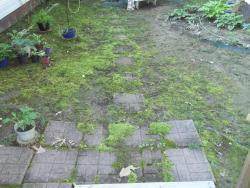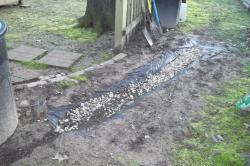MaryJane,
I've agonized for days about whether to post this or not, but I must; it's on my mind constantly! I don't want this post to seem negative or discouraging, rather I'd like to help you avoid a tough situation down the road...
We tried weed block fabric here and it was a nightmare. It only takes one short-term, garden-less event to start a chain reaction of trouble. As water flows through your seasonal stream bed it'll bring with it debris, soil and weed seeds; plenty of which will get caught in your rocks. This will provide perfect conditions for those seeds to sprout. If you are unable to weed it out for say, a two or three week period, at the right time of the year, they'll root through the fabric and be next to impossible to easily remove.
I'd recommend removing it before you go any further, or at the very least, don't plant through it. That way, if it ever becomes necessary to dig out half-grown weeds, you'll be able to...without ripping out all of your hard work, possibly losing plants, and having to start over. Moving rock and ripping out small sections of stream bed fabric would be enough to do...if it came to it.
All of these cautions would be moot, I guess, if you use a weed killer product, but if you don't, at some point in time you'll very likely need to be able to dig. Weed block fabric prevents digging.
***
As to plants...
If you have a lot of moss your area is probably cooler and mostly shaded?
Early bloomers that want wet to bloom and drier conditions afterward in order to go dormant or semi-dormant come first to mind, but with clay soil, as long as the light conditions are met, I'd think that many plants would flourish there. Plant a bit higher than usual, and just after the rainy season is over and they should be well-established and able to cope with moving water by the next.

Just my two cents worth...sharing what I've learned in 20 years worth of seasonal stream bed gardening. (Hmmm...that's a penny per decade!

)

Best to you in your endeavors!




